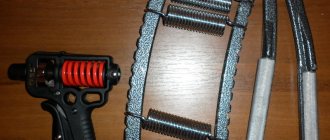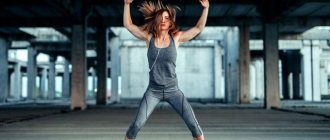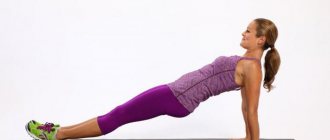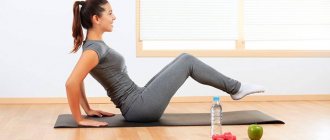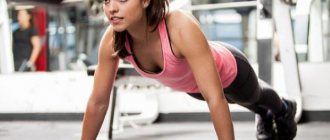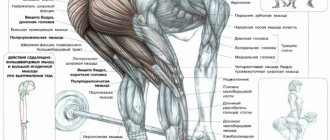What muscles does the mountain climber exercise use?
If we consider mountain climber exercises from the point of view of biomechanics, then we can draw a conclusion. That almost all muscles get a load. Only some of them work dynamically, directly performing the movement itself. Others act as stabilizers receiving a static load. Let's take a closer look at the role of muscles in this exercise.
- Abdominal muscles. These include: rectus abdominis
,
obliques
and
transverse abdominis
. All of them are responsible for stabilizing the pelvis, preventing it from sagging down. When it comes to climbing exercises, the first thing they talk about is the development of the abdominal muscles. - Leg muscles. Let's start from the bottom up. Bending the leg at the knee joint occurs due to contraction of the calf muscles
.
Next, the quadriceps
.
Especially long head. Due to its contraction, the leg bends at the hip joint and brings it to the chest. The hamstrings
and
gluteal muscles
are responsible for the reverse process. They extend the leg at the hip and knee joints. At the same time, the gluteus maximus acts as a pelvic stabilizer. - Back muscles. This includes almost all the muscles of this group. Diamond-shaped
and
trapezoidal,
work statically and are responsible for stabilizing the shoulder blades.
The lats
help
the back extensors
stabilize the spine.
The iliopsoas
muscles, together with the long head of the quadriceps, bend the leg at the hip joint. - Deltoid. In particular, the front and middle heads. They act as shoulder stabilizers.
- Pectoral muscles. Together with the deltoid, they stabilize the humerus. These include: the pectoralis major, pectoralis minor and serratus anterior muscles.
- Arm muscles. Triceps
and
biceps
. Responsible for stabilizing the elbow. They work statically.
As you can see, a very large number of muscles are involved in this exercise. Of course, by doing this, we will not be able to influence their size. But on the other hand, their strength and endurance will increase.
Benefit
In the climbing exercise, different muscle groups receive intense load. It is rightfully considered universal and truly effective. Are the benefits of rock climbing limited to abdominal training? The exercise is useful because it engages different muscles, strengthening and toning them. With its help you can achieve the following results:
- General strengthening of the deep muscles of the trunk, which ensures stabilization of the spine.
- Tighten and tone your arms, legs, and abs.
- Maintain a healthy spine and royal posture.
- Strengthen the muscles of the lower body, work on the elasticity of ligaments and tendons.
- Ensure natural compaction of bone tissue.
- The exercise can be used as an effective warm-up.
- The climbing exercise helps burn calories at an intense pace, which is effective for developing sculpted abs and overall weight loss.
- Increase endurance during physical activity and overall vitality.
Benefits of this exercise
- Performing this exercise allows you to increase the strength and endurance of the muscles of the whole body.
- With the help of the climbing exercise, you will strengthen your abdominal and back muscles. Which will make your waist look flatter. And it will improve your posture.
- Working at a fast pace can strengthen your cardiovascular system and overall endurance.
- By strengthening the back muscles, the risk of spinal injuries will decrease.
- To perform the climber exercise, no special equipment is required. What makes it accessible to everyone and gives the opportunity to train not only in the gym, but also at home.
- When performing a mountain climber, your metabolism increases and a large number of calories are burned. Therefore, this exercise will be indispensable for overweight people.
- The climber exercise is suitable for both beginners and more professional athletes. The main thing is to choose a pace and range of movement that is comfortable for you.
- This exercise has a very large variation in execution. Therefore, you can always diversify your training program and at the same time work your muscles from different angles.
As you can see, the list of advantages is very impressive.
Training programs
Mountain climber is a universal exercise that is suitable not only for beginners, but also for professionals. Wide differentiation in technique turns it into a full-fledged basic complex that uses almost all muscles in the body. At the same time, in the absence of additional weighting, it is almost impossible for them to be injured.
| Name of the complex | Exercises | Subspecies | Target |
| Aero |
| Bipedal climber at high tempo | Cardio |
| Circular |
| Classic variation | Global workout of all muscle groups |
| Home |
Perform at speed. | Standard | Strength-endurance |
| Home pro |
Perform in a circle until complete failure in one of the exercises. | With body rotation | Strength-endurance |
| Base hall |
| Any kind | Working out all muscle groups |
Important : remember that under one name there is a whole complex hidden. Therefore, when drawing up your own program, carefully look at the “type” column so as not to get an unnecessary load in the complex.
Execution technique
If you look from the outside, the climbing exercise seems quite simple. Take a lying position and alternately pull your knees to your chest. But as soon as the athlete begins to perform it himself, the opinion changes radically. Before you begin the movement itself, you need to correctly adopt a lying position. In the modern world, this stance is better known as the PLANK EXERCISE. And many who tried to stand in it for even a minute know that this is not an easy task.
Initial position:
- Lie with your stomach down. Place your palms on the floor in line with your shoulders.
- As you exhale, straighten your arms and press your body up.
- Next, starting from the head, we tense the muscles one by one.
- The head should be an extension of the spine. That is, we do not lift it up or lower it until the chin touches the chest.
- The shoulder blades are spread apart and lowered down due to contraction of the serratus anterior muscle.
- The body does not hang on the shoulders. On the contrary, the deltoids are tense and the torso is raised up.
- Next, we tense the abdominal muscles: the rectus and external obliques. This way we will prevent the pelvis from falling forward.
- We also strain our gluteal muscles. They will pull the pelvis towards themselves, due to which the spine will straighten and it will be easier for us to tense the abdominal muscles.
- The legs are completely straight and rest on the floor with the tips of the toes. The feet can be placed next to each other, or placed shoulder-width apart.
- We check ourselves, the neck is straight, the muscles of the back, chest and shoulders are tense. The abs and buttocks are in static tension. Legs are straight.
- Our body from head to toe should form a straight line.
Performance:
- Exhale and lift one of your legs off the floor. In this case, the weight is evenly distributed over the 3 remaining support points. Two hands and one foot.
- By contracting the iliopsoas muscle and the long head of the quadriceps, we pull the leg towards the chest.
- Work within the range that your flexibility allows. Having brought the leg to the maximum, we inhale and distribute it, returning to the starting position.
- We do the same with the second leg.
Modification for beginners - low impact
To do the “Climbers” exercise in its classic form, you need to be a sufficiently prepared person. For a beginner who has not only run, but also not done gymnastics for a long time, it will be difficult to do everything as it should. For dummies, a low-impact, simpler and more affordable option is perfect. It is done like this:
- Get into the starting position, the same one described above. In fact - in a regular plank.
- Stretch your body into a “string”, place your palms under your shoulders, tighten your abs.
- Next, instead of running, simply pull one leg, then the other, to your chest (or to your stomach, as it turns out).
- You can make the load even less if you do everything slowly enough and rest your hands on a stable chair.
Perform this modification every other day, gradually increasing the time and speed.
After 3-4 weeks you will be able to move on to a more advanced option. And then even try more complex types.
Recommendations for implementation
- When performing, you need to be as focused as possible on the work of the target muscles. From tension of the rectus and oblique abdominal muscles, to contraction of the quadriceps when bending the leg.
- When performing the exercise, the pelvis must be fixed. There is no need to lift it up or down when bending your legs.
- Keep your back and buttock muscles constantly tense. This will prevent your pelvis from sagging.
- When performing the classic version, your arms should be completely straight. If you keep them half-bent, then a greater load will fall on the triceps and biceps. And their fatigue can occur faster than the abdominal muscles.
- If you experience pain in your wrists while performing. Then you can use small dumbbells as a support. Place them on the floor, perpendicular to each other, and grasp them with your hands. Or take a fist stand.
- It is best to perform the exercise in shoes with rubber soles. This will prevent your feet from sliding on the floor.
How to include an exercise in the program
Climber is a great addition to any type of workout. In cardio, it can be included at the end, as an additional strength load, after the muscles are warmed up - they will receive the maximum benefit.
In a strength complex, it is worth placing the “climber” at the beginning. Several approaches will not let you get tired, but will thoroughly work out the muscle fibers of the whole body in order to prepare them for further loads.
You can do it in circular and interval complexes. Here, inclusion can be at any stage, either several approaches at once, or between performing other exercises.
It is suitable as a minimal fat-burning complex for those who have absolutely no time for training. To do this, it is recommended to perform “climber steps” for 4-5 minutes with an interval of 3 seconds between approaches. The number of calories burned will depend on the correct execution and pace.
Exercise options
As mentioned earlier in the article, the rock climber exercise has a large number of execution options. Depending on how you make the movement, the emphasis of the load on certain muscles changes.
Climber exercise with hands resting on a hill
To perform this option, you will need some kind of elevation. This could be: a step platform, a horizontal bench press, or a chair without a back if you train at home. This option is perfect for beginner athletes. By changing the angle of inclination upward, the press will be slightly unloaded. Because for us, it is more natural to be in an upright position. At the same time, the load on the gluteal muscles will increase. Otherwise, the principle of performing the exercise is exactly the same. Get into a plank position with straight arms. Only now we rest our palms not on the floor, but on a bench or chair. And we bend our legs one by one, pulling them to the chest.
Climber exercise standing on elbows
This option will relieve stress on your arms and shoulders. Giving you the opportunity to concentrate as much as possible on working the muscles of the abdominal cavity, pelvis, legs and back. Since we are now standing on our elbows, our body will be located much lower. And bringing a bent leg will be much more difficult. Therefore, we will have to move the hip to the side a little. And now we will lead the leg not to the chest, but to the elbow. Due to this technique, additional load will fall on the oblique abdominal muscles.
Side Twist Climber
Performing this option will shift the emphasis on the oblique abdominal muscles. It is perfect for athletes who want to reduce their waistline. Girls really like to do it. But this does not mean that this option is not suitable for men. In order to get that same twist, you need to pull your leg towards the opposite elbow. For example, the left knee to the right hand and vice versa. There is no need to further expand the body while driving. This will not affect the effectiveness of the exercise in any way.
Climber exercise with emphasis on the ball
You can use any ball, as long as it is hard. A medicine ball with special handles on which the palms are placed is also perfect. Due to this, the load on the wrists is reduced. This option is designed to develop coordination and helps to load smaller stabilizer muscles. Also, at the moment of lifting the leg, the abdominal muscles are additionally activated. Without giving us the opportunity to fall to the side.
Reverse climber
This type of climber exercise is less common than others. To perform it, we need to take a plank pose with our backs down. That is, now we rest on the floor with the heels of our feet, and not with our toes. In this pose, the load shifts to the muscles of the legs and pelvis. The abs are also tense. But his role is becoming significantly smaller. Raising your leg will be much more difficult. Therefore, the quadriceps and iliocostalis muscles will have to turn on at full capacity. The principle of implementation is this. Take a plank pose with your back down. The body should be straight, from the heels to the crown. As you exhale, bend your leg and pull it up towards the pectoral muscles. As you inhale, lower it and do the same on the second leg.
Bipedal climber
This option is the most difficult of the above. To perform it, you need to have very strong arms and shoulders. So that we can control the weight of the body at the moment the legs lift off the ground. This option is aimed at working the rectus abdominis muscle. It's worth doing it at a fast pace. The technique is slightly different from the classic version. We stand point-blank lying on straight arms. We take a breath and jump up a little. At the same time, by contracting the rectus abdominis and quadriceps muscles, we bend our legs and slightly twist our pelvis forward. As soon as we land on our toes, immediately while inhaling we do a reverse jump and return our legs to their original position.
Tips for maximum efficiency
- The classic version can be performed at a fast pace. From the outside it will resemble horizontal running in place. This technique can be used at the end of a workout, thereby replacing a little cardio before starting a COOL-DOWN.
- If you want to increase the intensity of this exercise even more. Then you should use weights with sand or a rubber expander. If you train at the gym, you can attach your legs to the crossover cable.
- In order to further load the abdominal muscles, you can use the principle of “pre-exhaustion”. That is, first we do classic crunches while lying on the floor. Thus, we tire the abdominal muscles. And then we perform a climber. Finishing off already tired muscles.
- Beginner athletes can perform the climbing exercise in a jumping style. The principle is the same as in the two-legged version. Only we alternate each leg. This technique will help the muscles and ligaments adapt to movement.
- Be sure to work on the flexibility of your muscles and joints. This will allow you to work at full range.
- If you find it difficult to maintain a stable body position while performing the exercise. Then you should start mastering with a regular PLANK. Doing this will strengthen your muscles and make it easier for you to control your balance.
The climber exercise can be very effective if you adhere to the execution technique. For greater results, it is worth performing it in combination with other exercises for the abdominal muscles. It is also extremely important to increase the intensity by moving from simple to more complex options. And believe me, your muscles will just burn.
Good luck to everyone in your training!
Errors during the exercise
There are a few things to watch out for when doing this:
- The correct technique should become habitual. Many novice athletes do not pay enough attention to technique during their first training sessions, which makes it difficult to retrain. The complex will not be effective if you perform the exercise with errors. When trying to correct them, muscle memory returns the body position to its usual one, so from the very first time you need to pay special attention to the correct technique. To develop the correct dynamic stereotype, for the first time the “climber” must be performed slowly, fixing the knee to the chest in the correct position.
- The body weight is placed evenly, it does not shift to the right or left side, and the body does not collapse when pulling up the leg. The press is constantly tense to the maximum.
- The shoulder blades should be relaxed. The back should be tense, and the shoulder girdle should be relaxed.
- Too long pauses reduce the effectiveness of the workout. The pace should be uniform, slow at first, then accelerate, without unnecessary stops or breaks. You can rest between sets, but not during the process.
- Bouncing on your toes. This increases the heart rate, but removes the load from the muscles, so it does not contribute to the correct execution of the exercise.
- Touching the floor with your toes while pulling up to your chest. This significantly reduces the pace, reduces the load on the abdominal muscles, and they are worked much worse than when the limb is completely torn off the surface.
All of these common mistakes need to be monitored so that the “climber” brings maximum benefit to the body and the entire organism.


